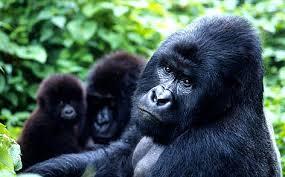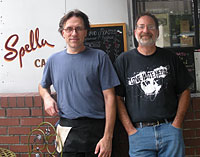
TIP: You can save products to
your favorites list if you log in
Have we shared how much we love African coffees? Ethiopia (aka The Mothership), Kenya, Rwanda, Tanzania, Uganda and Burundi have tantalized roasters from time immemorial, and now we are adding, for the first time,
a beautiful newbie from DRC. One of the vastest and most historically complex countries in all of Africa, the Democratic Republic of the Congo (DRC)also known as Congo-Kinshasa, DR Congo (French: RD Congo), the DROC,[8] or simply either Congo or the Congo, and historically
Zaire, is a country in Central Africa. It is, by area, the largest country in sub-Saharan Africa, the second-largest in all of Africa (after Algeria), and the 11th-largest in the world. With a population of around 103 million,[9] the Democratic Republic of the Congo is the most-populous officially Francophone country in the world, as well as the 2nd-most populous country in Africa (after Nigeria),
and the 13th-most populous country in the worldThe farming community in North Kivu has become accustomed to adversity. Armed incursion, corruption and disease are part of everyday life, but in coffee they see hope.
Coffee is one of the only cash crops these producers grow. It puts money on the table, brings stability to the community and enables farmers to plan.
The Kawa Kanzururu Cooperative is an exciting new Coop with a network of 24 micro-mills along the western rim of the Rwenzori Mountain Range. The benefit of working
through a Co-op is of huge importance to smallholders since North Kivu is landlocked. Plugging Congolese coffee into the global supply chain means transporting it to
the Port of Mombasa in Kenya to reach the sea. Thus, working collectively is essential. The Kawa Kanzururu Coop is also focused on expanded production and quality. Expect your
pourover or drip to produce a rich, heavy-bodied cup with nice notes of dark chocolate, pineapple and lemon-lime.
The farming community borders the Virunga National Park which occupies the Semliki River Valley in the 140 km stretch between lakes Edward and Albert in the westernmost
arm of the Great Rift Valley. Cocoa and palm oil are also grown in the lower zones, and new crops such as chia seed are also starting to take root. The conditions
here are ideal for growing coffee: deep, fertile, volcanic soil, high altitude and adequate rainfall.
About Virunga National Park and North Kivu
Located at the borders of Uganda, Rwanda and Burundi, the Kivu area is home to coffees with stunning cup profiles. While the area is subject to on-going conflicts,
a cooperation between coffee farmers, Farm Africa and the Virunga National Park is encouraging peace through the growing of specialty coffee. Established in 1925,
the Virunga National Park is the oldest national park in Africa and one of the last refuges of the mountain gorilla. It is also home to highly
endangered lowland gorillas as well as elephants, chimpanzees, lions, leopards, antelopes, and the most diverse collection of birds in the world. Due to its situation
in eastern DR Congo, the park faces many existential challenges.
For Virunga National Park the conservation of its extraordinary wildlife goes hand in hand with the promotion of the social and economic well-being of the people of
North Kivu, who live around the park. Through the Virunga Alliance, which is supported by the provincial authorities, civil society and the private sector, the national
park is investing in a number of initiatives to promote economic regeneration – most notably a major hydroelectric generation and distribution venture. This is already
bringing employment opportunities as well as access to electricity for thousands of households. The park is also embarking on a major agriculture program with the
vision of boosting the livelihoods of smallholder farmers who live around the park by investing in the production and marketing of their food and cash crops, including
coffee. In this way, the pressures on farmers to encroach on the park to extract wood for charcoal will be reduced and farmers will see benefits from the park's
presence.




